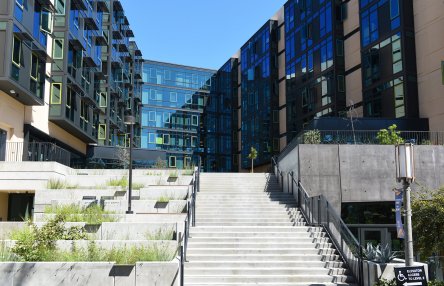The state of commercial real estate has been significantly changed by the COVID-19 pandemic. The industry has seen a steep rise in the need for tech platforms to drive revenue and facilitate remote work to keep offices safe and productivity high. Spending on advanced technology According to CBRE research presented by Stuart Appley on a recent Realcomm webinar, 57% of companies were increasing spending on digital transformation prior to COVID. Moving forward, 70% of executives say digital transformation spending is likely to accelerate. A deeper dive into the numbers shows that increased spending is driven largely by business growth opportunities (51%) and increased competitive pressure (41%). The focus of the spending is primarily on modernizing customer touchpoints and enabling infrastructure, 54% and 45% respectively. In other words, operators are spending on tech that allows them to grow their business and to keep up with the competition, specifically by creating or implementing new systems to eliminate physical touchpoints. Health and wellness standards will need to be consistently monitored in order for offices to return to normal business. Appley, managing director for CBRE described some of the digital advances that companies are examining and implementing: Drones to perform building inspections Machine learning Robotic process automation Virtual reality training and virtual space planning Blockchain to digitize assets A poll in the Realcomm webinar, showed that 85% of attendees believe the rate of tech adoption will increase due to the effects of the pandemic on businesses. Innovative projects and IT strategy Executive decisions on IT should address several key metrics: increase asset value, reduce expenses, increase tenant retention and drive revenue. “If you build your IT strategy around these points, you will be successful,” said Brian Sutherland, industry principal at Yardi. Moving payments online is something that has...
Lease Performance Now...
CRE and COVID-19
It’s hard to imagine entering August with the COVID-19 pandemic still causing mass disruption throughout the commercial real estate industry. While there are varying degrees of guidelines and protocols for reopening buildings, the general consensus is that a large percentage of tenants needed help to navigate these times. Whether it was in the form of rent concessions, deferrals or any other tactic to prevent going under, tenants are reaching out to property managers more than ever. As part of Yardi’s Innovator Sponsorship of the July CRETech virtual conference, Brian Sutherland, commercial industry principal, had a chance to host a discussion with Paul Gaines, managing director of asset management for Accesso Partners. Accesso, based out of Hallandale, Florida, manages a portfolio of over $3.3B in assets across 21 cities in 8 states. Managing Deferral Requests Gaines explained they initially had 150 tenants across the portfolio who requested rent relief. Accesso then requested three things: 1) Ask the tenant to look thoroughly at their insurance coverage for any pertinent information. 2) Ask the tenant to apply for government assistance. 3) Ask the tenant to send complete financial documentation to Accesso so they could work on a plan together. Gaines revealed that his company had been able to reach agreements with 35 tenants on lease amendments or deferrals, without granting any abatements. While it’s a difficult time for all, it is important to realize the difference between those who truly need assistance and those who simply aren’t able to use their office space but are continuing business operations successfully. Thanks to quick and concise decision making within the executive team at Accesso and consistent communication with tenants, Gaines said they have seen 96-97% timely collection across the portfolio since work from home orders were enacted. The senior...
Assisted Living Aid
COVID-19 Relief for Providers
Testing kits, sanitization materials and personal protective equipment are essential tools in the battle against COVID-19 for senior living providers. Unfortunately, these resources are ballooning budgets for organizations already operating on thin margins. So as talks of further coronavirus relief packages continue in Congress, a coalition of senior living associations are pushing for direct aid to help cover these costs and ensure resident safety. AHCA/NCAL, Argentum and LeadingAge have taken a clear position: Billions of dollars in relief have already been given to health care providers, including skilled nursing facilities, but private-pay assisted living has so far seen no financial support. Their call for aid is being echoed by lawmakers too. Rep. Kay Granger recently wrote an editorial on The Hill requesting the U.S. Department of Health and Human Services (HHS) to provide help and resources to senior living facilities. “The administration did a good job of prioritizing nursing homes early on in the pandemic so that they could get the personal protective equipment (PPE) supplies they needed. But many of our elderly don’t live in nursing homes; they live in senior living facilities, like Sagora Senior Living in my congressional district,” Granger writes. “We need to focus on getting resources to help these vulnerable Americans. And we need to do it now before it’s too late.” To facilitate a potential distribution, the senior living group built an online portal where providers could enter their information. The data is now being packaged for the HHS, which has been allocated COVID-19 relief funding from the CARES Act passed in March. The associations want to stress that there is no guarantee the funds will be received, but the effort does bring the private-pay industry one step closer to seeing it happen. And although the current deadline...
5G Technology
Impact on CRE
What do we know about 5G connectivity at this stage in its development? First, we know it’s nowhere near the capacity it will have in the coming years. Second, we know that it will provide an incredible speed increase over 4G (potentially 100x faster downloads). Third, we can safely presume it will have a significant impact on commercial real estate. In a recent session at the 2020 Virtual BOMA Conference, Yardi solutions consultant David Franklin explained how 5G is already beginning to transform the industry and reshape communication standards. A world of new possibilities “The change to 5G will be as significant as the change from analog to digital,” Franklin said. While timing is still unpredictable, 5G will become ubiquitous. Existing cell towers may not have to be replaced and, while there will be millions of new towers that pop up, 5G connectivity will be available everywhere. This is due to the fact connection points will become easily installed anywhere from light poles to bus stops. The world of 5G connectivity will enable new apps and facilitate robotics and other AI and IoT enhancements. While 4G brought the capacity to video conference and download and upload at new speeds, 5G is going to top that by “connecting massive amounts of devices with very low latency,” Franklin explained. The progress made by 5G will empower a huge number of low-cost devices with low energy consumption related to IoT. The Internet of Things is already comprised of an extensive list of interconnected devices, but with 5G becoming more prevalent, this will enable more data collection, deeper data analysis, faster communication and, of course, new devices and tasks. Real estate operation already relies on IoT-related components such as thermostats, security cameras, lighting controls and energy conservation systems....
Learning Resources
Job Aids for Yardi EHR & eMAR
For EHR systems, workplace training is essential. The software helps nurses deliver quality care, so it’s important that they become proficient in electronic charting and medication order management. Once they’ve learned the ropes, they get to spend more time with residents and less on technology. But when things change rapidly, as the case has been with COVID-19, it can be difficult to conduct enough hands-on training to bring staff up to speed, so it’s smart to provide extra learning resources to ensure they have the information they need, right when they need it. As a recent example, one senior living client of ours had the idea to create handouts for agency nurses who are supporting staff during the pandemic. Some of these new nurses were unfamiliar with Yardi EHR, so they were resorting to charting on paper. To get the nurses on track, the client created a two-page handout, featuring screenshots and instructions, that outlines what to do at the start, during and after a shift. It effectively guides the nurses through the essentials of a shift in Yardi EHR, and it even offers some troubleshooting in case they get stuck. The handouts have proven successful as a support tool across their communities. In that same spirit, we’ve created over a dozen job aids for Yardi EHR and Yardi eMAR to facilitate learning and help your staff be more productive. Each document covers one task (like adding new orders or updating a physician’s contact information) in clear, easy-to-follow language that caregivers can reference if they’re new to the process or just not quite sure about the steps. Here’s a quick rundown of what our new Yardi EHR and Yardi eMAR job aids explain: Adding, verifying and linking orders (both medical and non-medical) Navigating a...
5 Tips to Prevent
Property Manager Burnout
Property management staff members are burnt out. We hear your concerns: addressing financial issues, public safety and frustrated residents have added additional stresses to an already demanding job. As property management leadership, you play an essential role in preventing burnout for yourself and others. Leasing agents are discouraged and need your support Social distancing is dragging on and very, very few people are happy about it. Property management must decide how to reopen multifamily amenities and enforce social distancing policies—decisions that are bound to upset people. Additionally, while many employers are grasping for business as normal, others are closed or operating on a skeleton crew. This financial uncertainty is challenging for residents and the staff that tries to assist them. Your staff members need your support and insights. Perhaps once a week at the end of the day, host a meeting that allows staff to share the challenges that they’re facing. This is an especially important time for you to listen as listening reduces the frustration of conflict. To help you get started, we’ve identified a few common pain points that might arise and how to address them: Help staff communicate a fair, consistent message for residents Agents are receiving lots of calls and emails. Many are from residents who want refunds for amenities and services that they haven’t been able to use as expected. Encourage staff to listen and mirror residents’ concerns. Then ensure your staff knows how to address residents’ concerns and offer a fair response. If you will be offering concessions, create consistent guidelines that staff can use. If you are not offering concessions, help staff craft the verbiage needed to explain why. When agents understand your expectations and know what to say, you can reduce the frustration of communicating with...
Apartment Onsite Teams Day
Celebrating Essential Workers
We’re excited to participate in the first Apartment Onsite Teams Day on August 12, 2020. The day has been designated by the National Apartment Association at the request of industry leaders to recognize onsite property teams throughout the country for their work to keep people safely housed during the COVID-19 crisis. Celebrate onsite workers Apartment Onsite Teams Day recognizes the people who have helped guide apartment communities throughout the U.S. through this unprecedented and uniquely challenging event. “With the advent of the coronavirus pandemic, our onsite management teams became our first responders. On this special day, we want to take the opportunity to express our gratitude for your leadership, your sacrifice and your care of our residents, our teammates and our clients,” said Mike Holmes, president of Easlan Management and NAA chairman. “The fight must continue, but we want to set aside a day to let you know how much you are appreciated. We all stand with you.” Nominate your heroes NAA has compiled an Apartment Onsite Teams Day toolkit to help property management companies thank their teams on this day in a variety of ways, from social media posts using the #APTeamsDay hashtag to safe, socially distant parties. Here at Yardi, we’re amplifying the celebration by inviting everyone to nominate onsite team members that are making a difference. It’s easy to participate. Simply grab a screenshot of the graphic below and fill it out. Or just retype it in your own words. Then post it on Facebook, Twitter, Instagram and/or LinkedIn. You must use the hashtag #APTeamsDay and tag Yardi to enter. Five winners will be selected at random on Friday, August 14. Winning posts will receive two $25 gift cards. One will be sent to the post creator, and the other will be sent to the person or team they nominated. It’s a nice way to do a little something extra for those supporting the many renters spending more time at home this year. “The apartment industry’s onsite team members have been on the frontlines throughout the COVID-19 pandemic, committing themselves to performing the vital work necessary to keep the community together during these trying times,” said Esther Bonardi, vice president of marketing at Yardi. “We invite you to join us in promoting the amazing work of our onsite teams.” We encourage you to get creative when showing appreciation for the people in your communities who have gone above and beyond. Add photos or videos and encourage your residents to participate too. We’ll be resharing some posts starting now through the end of the contest. Stay tuned It is our hope that Apartment Onsite Teams Day continues in the years ahead to applaud the ongoing commitment of onsite teams who work hard to keep residents happy and properties running smoothly. Don’t forget to give a shoutout to your favorite #APTeamsDay heroes for a chance to win! We look forward to highlighting your submissions on our social platforms throughout the week. See complete contest...
Safe Workplaces
Tech to help during COVID-19
We are nearly four months into the COVID-19 pandemic and businesses have had to adjust their daily operations to reopen for staff and guests. Every aspect of sanitation, proper distancing, touchpoints and other routine business functions are now altered to improve the safety and peace of mind of workers returning to the office. Coworking industry case studies On a recent Realcomm webinar, Yardi vice president of coworking, Dale Hersowitz, said that some aspects of technology already being implemented prior to the pandemic are now even more useful to help maintain productivity and safety. For example, in the coworking industry, fully transactional websites and apps for meeting room bookings, desk reservations and virtual space tours help facilitate a completely distanced and safe experience. Staples, whose brand is most associated with office supplies, started a coworking brand in 2019 called Staples Studio. They repositioned part of their stores into shared workspaces and on their website they list everything from meeting room space to private offices, making it quick and easy for a prospect to become a member and complete transactions. This shift to a mobile experience has begun to replace the in-person meeting with a front desk associate or community manager and it now grows to more prominence during COVID. “One of the keys is to use apps that will not only show you the product but the availability of the product,” Hersowitz said. In coworking, member retention is always a driving factor with a high turnover rate month-to-month. One of the main ways to increase retention while members are still largely not entering your space is to use apps that allow for as much community interaction as possible. Launch Workplaces, a Maryland-based coworking space with six locations, is using a member portal to drive community,...
Stable Investment
Future Affordable Housing
Through the best and the worst economic times, affordable housing has emerged as a stable sector. The demand for affordable housing continues to rise while creative private partnerships deliver fresh capital to fill the pipelines. With those conditions aligned, affordable housing is an investment that can weather turbulent times. Enduring investments Multihousing News reports a continuing upward trajectory for affordable housing demand. The current pipeline is insufficient to fill the current need, and if recessionary conditions prevail, the demand for affordable housing will continue to drastically outpace supply. While demand may pique investors’ interest, alone it is not enough. Affordable housing may prove to be more beneficial investment than other multifamily assets due to Section 8 vouchers. The rental housing assistance program creates a barrier of protection around privately-owned affordable properties. During tough economic times, Section 8 vouchers limit rent default rates in comparison to market rate housing. The benefit of investing in affordable housing extends beyond ongoing demand and security against defaults. Affordable housing leaders are positioning themselves for longevity and stability. Creative partnerships Public-private partnerships are becoming more prevalent, offering creative solutions for funding, development and property management. Individual firms as well as municipalities have come to rely on public-private partnerships during the ebb and flow of economic trends. Private firms are respected for their ability to complete projects while balancing quality and efficiency. Most commonly, private general contractors will use their connections to development and construction firms to complete projects for local governments. There are, however, exceptions to this dynamic. Yardi client Conifer Realty forged an investment partnership with Belveron Partners that allows Conifer to develop, build, own and manage properties under one roof. Conifer’s investment extends beyond a single project or portfolio to a company-level partnership that is a game-changer...
Simplified Claims
Claims Manager
Does the thought of Medicaid billing illicit groans from your staff? That’s understandable. Manual billing is time consuming, frustrating, and often riddled with errors. Fortunately, you can boost staff morale and productivity with automated billing for Medicaid. Claim submission woes can lead to high turnover Medicaid provides consistent and vital funding for senior care. But the variables in filing processes and reimbursement can cause headaches for staff. Complicated filing practices can result in costly errors, wasted time, and delays in reimbursement. Those frustrations are just the beginning of more troubling issues. As employee frustrations add up, turn over increases. High Speed Training of West Yorkshire reports on the top five reasons for high company turnover. A lack of innovation and overworked employees are two factors that drive employees out the door. When companies fail to adapt innovative practices and technologies to support their staff, the staff suffers. Staff members are unnecessarily burdened with inefficient, redundant, unfulfilling work and stress. As a result, turnover rates soar, and organizations fail to reach their potential. Simplifying Medicaid claim submissions Claim submissions are a pain point that developers with Yardi Senior Living have heard about for years. A game-changing solution is now available. Yardi Claims Manager, the newest update to our Yardi Voyager Senior Housing platform, streamlines and simplifies the claims submission process. With Claims Manager, you can: Get Organized Manage all Medicaid claims in a single, secure database. There is no need to shuffle between multiple software programs or websites. Improve efficiency Electronic submissions eliminates the need to sort, scan, and house files. All documentation is securely stored in Yardi. It’s easy to create, submit, store, and reconcile files. Improve accuracy State-specific billing templates make it easy to fill out claims with the information needed in your unique...
Stories of Hope
Lifting Spirits in Senior Living
Although a few states have begun relaxing visitation restrictions for assisted living facilities, the pandemic isn’t over yet. So senior living providers have continued to follow stringent protocols for protection. They’re doing all they can to keep residents healthy – and happy. Here’s another roundup of clients with uplifting stories to brighten your day: Festivities for Father’s Day Since families were unable to celebrate Father’s Day in person with their loved ones, staff at Merrill Gardens went above and beyond to make the day special for the dads in their communities. Employees in Monterey created little gift bags, provided lunch and hired a live jazz band to brighten things up. Staff at other communities, including Willow Glen and Madison, did their own versions of gift baskets as well. Check out Merrill Gardens’ blog post for the Father’s Day photos. Bringing families one step closer Over the past few months, many senior living communities have implemented their own version of window visits or visiting stations with barriers to protect residents. Aegis Living has taken the idea one step further by designing “outdoor living rooms,” complete with comfy chairs and decorations, to go with the plexiglass shields. “With each passing week of residents being physically separated from loved ones, we knew we had to find a better way,” said Kris Engskov, president of Aegis Living. “Design consulting and support from infectious disease experts and physicians helped us create these beautiful, new Outdoor Living Rooms to bring families together again – safely.” Horses with hats pay a visit While there’s no replacement for a family member dropping by to say hi, there’s no stopping a smile if horses in a clown hat and tiara walked up to your window. At Maple Wood Alzheimer’s Special Care Center, that’s...
Matrix Studies Up
Student Housing Insights
As colleges and universities announce varied plans to cope with coronavirus this fall, what will be the impact on student housing owners and operators? Some definitive answers were delivered in a July 15 webinar from Yardi Matrix, which also marked the launch of the Yardi Matrix Student data service. Market coverage includes over 2,000 universities and colleges nationwide, including the top 200 investment grade universities across all major collegiate conferences. Reports will also include data into shadow markets, defined as campus-proximate housing that often is rented by college students, though it may not be labeled as dedicated student housing. “The college experience is going to change, and has to change until there is a vaccine in place. This is a fall semester issue and probably into the middle of the spring semester,” Jeff Adler, vice president of Yardi Matrix, told the over 400 attendees at the outset of the online presentation. But that’s not all bad news for student housing, especially for providers with shadow market properties. Of the 200 universities Matrix researchers surveyed for the first study, many have announced plans to reduce dorm capacity levels to accommodate social distancing protocols. This means that more than 60 percent of students attending schools in the Yardi 200 will be living in such shadow market housing – and the total national percentage is higher. “Reduced dorm capacity requirements are a tailwind for off-campus housing,” Adler said. “Is student housing pandemic proof? I would say that it’s pandemic resistant. There is some choppiness expected, but I think overall the sector is going to hang in there.” Long term, the U.S. is expected to see an overall decline in its population of college-age adults, but with more Americans than ever earning four year degrees, attendee figures should...
ICSC Webinar
CRE Adapts to Changing Times
In an ICSC webinar held in late June, Brian Sutherland, Yardi industry principal, moderated a panel discussion about how current economic and social challenges are forcing commercial operators to adapt to a changing market. They discussed the importance of AR management and evaluating tenant risk to accurately project future revenue and overcome the effects of the pandemic. Panel of experts: Gary Shaw – President, Arcadia Management Christine Mastandrea – EVP, Whitestone REIT Sutherland: On the Yardi side, in mid-March, we shifted 7,000 employees to work from home basically overnight. Can you talk about how you transitioned early in the response to the pandemic? Mastandrea: Within a very short timeframe we moved into a radical simplification mode. We expanded our meeting times to include more team members to be involved for consistency of communication all the way to the front-line ranks. We organized our team around four functions: client engagement, vendor management, stress testing and inner workforce. We moved our workforce offsite and we’ve gone from Zoom meeting to Zoom meeting. Client engagement is where we spent most of our time and we oriented about 80% of our workforce toward client engagement. We made sure we had our “four As”: alignment, assignment, accountability and then autonomy. We funneled all requests through one person in our legal department and made sure we had this process smoothed out over time. One major key was daily posting of cash collection and making sure everyone has an understanding of where we are and where we’re missing collection. We stopped mass emailing and instead got in contact on the phone with everyone we could, to understand who’s open and who isn’t, who is considered essential business and started discussing [Paycheck Protection Program] (PPP) funding. Shaw: We moved everything to the...
Building on Success
Impact Management Group
Impact Management Group, LLC has big plans for the future. The affordable housing property development and management company is set to expand its business strategy, and they have the experience, staff and investment in technology to help set themselves up for success. The new venture for Impact is into the fee management service industry. By this effort, Impact will assume property management and affordable housing program compliance responsibilities for properties owned by other parties, in exchange for a management fee. With the experience of managing approximately 1,400 affordable and market rate units across Wisconsin, Impact has a lot to offer clients. Their extensive industry knowledge not only boosts their credibility, but also serves as a valuable asset that potential clients can leverage to make their own affordable housing compliance programs more effective. Impact’s strategy to begin offering management services is to first focus on prospective clients with HUD 50059 units and properties, and then expand into management of portfolios composed of larger numbers of units, including Low Income Housing Tax Credit properties. Compliance mandates for these programs vary, and Impact’s experience will go a long way in helping its clients reduce the complexity of qualifying residents, calculating rents, managing vacant units, reporting to funding sources and more. A portion of Impact’s compliance expertise has been gained by support from RightSource. It’s expected that prospective clients will see how Impact works closely with RightSource and view the relationship as attractive in selecting a fee manager for their properties. “We couldn’t be where we are today without RightSource,” said Lisa Barkelar, vice president of Impact Management. RightSource, recently acquired by Yardi, offers compliance, consulting and training services, and specializes in serving clients of the affordable housing industry. All of RightSource’s software and services are now fully...
Relocations + Rent Drops
COVID-19 Prompts Migration
Already apparent in the U.S., COVID-19 has resulted in a migration from major cities and falling rents. As the housing industry braces itself against continued impacts from the virus, will both trends continue into the third quarter? Market analysts, real estate agents and renter surveys give us clues about what to expect. Are people really moving away from cities as a result of COVID-19? Yes. People are leaving cities to avoid COVID-19 risks and disturbances. Though it is a misconception that population density equates to higher risk, perception matters. The perceived increase in risk has made city residents feel less safe. That fear, coupled with other disruptions, motivates relocation for those who can afford it. Pew Research Center reports that 3% of U.S. adults moved due to the pandemic and about 6% had a member of their household relocate. Of those surveyed, 28% moved to reduce their risk of contracting the virus and 8% moved due to job loss. About 20% moved to be closer to family. Younger people make up a unique portion of those who relocated. Roughly 9% of adults ages 18-29 relocated due to the virus. This includes 23% of respondents who were university students forced to vacate their campuses. Even New York– the market trendsetter that has captured hearts for generations– is seeing mass movements to the nearby suburbs. Real estate agents Susan Horowitz and Monica Schwerberg explored the details in an interview with NPR. “We are seeing 20 offers on houses. We are seeing things going 30% over the asking price. It’s kind of insane,” Horowitz said. “It is a blood sport.” She adds, “Every last bit of it is COVID-related.” Schwerberg agrees, “In the month of April, where we typically would get maybe 75 inquiries in a month, we had over 400 inquiries.” People who once loved the city atmosphere are seeking locations with less population density, which is falsely assumed to correlate with increased infection risks. Additionally, many breadwinners are now working from home. Remote work opportunities have made commute times less of a factor in housing decisions. Since March 2020, about 10,000 New Yorkers filed for address changes to the state of Connecticut alone, reports Hearst Connecticut Media. Nationwide, U.S. Postal Service data indicates that southern Florida and southern California are popular relocation destinations. Who is moving during COVID-19? While some people are relocating due to job loss and financial difficulty, there is a correlation between job security, higher incomes and relocation. In short, households with higher incomes can afford to sell their current home (potentially at a loss) or terminate a lease early in favor of getting a new home in the suburbs. Higher income households are also more likely to have remote work. The ability to maintain income while working from anywhere permits the flexibility needed to relocate during the pandemic. Additionally, higher income households represent the demographic most likely to own a vacation home. About 13% of those who relocated moved into their second home or vacation home, reports the Pew survey. How does COVID-19 relocation impact the rental market? Yardi Matrix analyzed asset performance data from 107 major metropolitan areas between April and May 2020. During that time, multifamily rents declined by .4% nationwide. Overall, twice as many markets witnessed rents decline than rents rise. “Multifamily’s nearly decade long run of healthy performance increases came to an abrupt and unexpected end this year,” said Jeff Adler, vice president of Yardi Matrix. “Job losses have been particularly high among apartment renters, and simply collecting rents and maintaining occupancy is a new area of focus for owners and managers.” The report suggests that the pandemic’s influence on work conditions, public health metrics and social trends will continue to impact the housing marketing for the next several years. “If renters decide to eschew urban apartments for a more distanced standard of life in the suburbs or smaller cities, multifamily could...
Experts Assess
COVID-19 Energy Impacts
Along with tracking the momentous public health and economic implications of COVID-19, renewable energy advocates are keeping a close eye on how the pandemic is affecting the Earth’s environmental well-being. The International Energy Agency, which advocates for sustainable energy policies, reported that average global road transport activity fell by 50% of the 2019 level in the first quarter of 2020, while aviation activity declined 60%, spurring an unprecedented decline in world oil demand. The U.S. saw a 50% reduction in the use of jet fuel and 30% less gasoline consumed; meanwhile, natural gas use in commercial and residential buildings dropped by almost 20% from late March to early June of this year, according to a study of COVID-19’s effects on energy and the environment by researchers from the MIT Sloan School of Management, Yale University and Northwestern University. Reductions spark optimism “Overall, these reductions reflect a 15% total reduction in daily CO2 emissions, which is the largest annual percentage decline for the U.S. in recorded history,” says MIT Sloan professor Christopher Knittel, one of the researchers. The recent drop in consumption and emissions offers a glimpse of a cleaner future – if the effort is sustained after the crisis abates. In the wake of COVID-19, “it is essential that we build back better. We need to create a more resilient and sustainable clean energy system in order to reduce the risk of facing the catastrophic crises that climate change could bring,” says Jules Kortenhorst, CEO of the Rocky Mountain Institute, writing for the World Economic Forum. That means prioritizing structural changes that “make a real difference for the energy transition in the longer term” rather than jumping on “the bandwagon to push the green agenda in short-term relief packages,” say researchers from ETH Zurich’s...
Market Upsides
Maximizing potential as coronavirus continues
Even before the COVID-19 pandemic, multifamily market experts were talking about preparing for big economic changes. Now that rising unemployment rates, benefit delays and social distancing have created new challenges for real estate managers and renters alike, it’s time to re-think every aspect of your operations. Here’s some good news: there are real upsides to the downturn, including opportunities to move business online and improve communication to form stronger relationships with your customers. Read on for five key takeaways from Yardi’s operational strategies webinar that can help you right now and into the future. 1) Maximize marketing websites Apartment searches are on the rise and units are being rented sight unseen — and it’s all happening online. How can you keep up? Provide a virtual marketing and leasing experience from start to finish. Make sure your websites provide plenty of curb appeal for your listings, and include optimized photos, videos and 3-D floor plans along with virtual meeting and tour options. Offer live chat to answer questions from prospects and consider a chatbot when your agents are unavailable — a “contact us” email address or web form isn’t enough anymore. Use nudge marketing campaigns and page narratives to help prospects make timely rental decisions. And this is critical: bring your entire leasing process online from application to self-screening to lease execution with an electronic signature. Are you providing unit touring options? If you’re not offering self-guided tours yet, in this new world of contactless marketing it’s a great way to sign more leases. Even before the pandemic, self-guided tours were growing in popularity, and now they are a must to ensure social distancing and a contactless experience for your staff and customers. It’s important to plan for self-guided tours at the site level including the ability to verify prospect identities remotely before allowing access to your units. With COVID-19 concerns, you’ll also need a strategy for cleaning and sanitizing units after every visit. Once you figure it out, you’re likely to reap the benefits of agentless tours. 2) Consider strategy changes Take a good look at your marketing spend and identify which channels have provided you with long-term contracts and where your new opportunities are coming from. With a growing number of prospects willing to rent a unit sight unseen you need to take advantage of contactless opportunities. Ramp up your targeted marketing to those socially distant customers with a clear message about your easy online leasing process. Once you drive that motivated traffic to your website, those prospective renters can enjoy all the good stuff covered above including around-the-clock applications and leasing. 3) Send the right message Now is a great time to build stronger relationships with your residents. More than ever, communication with customers and within companies is critical. Be sure that your content, messaging and tone are not only aligned with your brand and our current reality but also resonate with what people really care about. We all need to feel safe and supported, and multifamily managers are in a unique position to create an inclusive and positive community for staff and residents. You can offer residents who are struggling financially payment plans and deferral options. If you haven’t accepted credit card payments for rent in the past, maybe now is the time to allow it to help keep your payment percentages high. There are also the day-to-day messages you need to push out to make sure your social distancing policies are followed when common areas and amenities are used. You will most likely see a big difference when it comes to renewing leases and keeping quality residents for the long term. 4) Reduce leasing risk With high unemployment and apartment fraud on the rise, you need to be sure you know exactly who you’re renting to. That doesn’t mean that prospects who are short on cash won’t be quality residents, so you’ll want to screen...
Mixed-Income Housing
Pennrose + Omni Make History
As the demand for affordable housing continues to rise, local governments form unique partnerships to fill the need with efficiency and quality. Three Jersey City governmental agencies and two Yardi clients have joined forces to execute Bayfront Redevelopment Plan which includes the largest mixed-income housing development in the Tri-State region. A clean slate The significance of the Bayfront Redevelopment Plan begins with its history. The West Side of Jersey City has had it share of ups and downs. The diverse neighborhood is currently experiencing a renaissance as a wave of investors aim to highlight the beauty of the neighborhood’s eclectic nature. The new development will breathe life back into the Hackensack Riverfront, making it a thriving part of the West Side rather than a forgotten nook. Additionally, the new development will provide the neighborhood with the economic stability that accompanies mixed-income housing. Bayfront Redevelopment Plan includes the transformation of the former Honeywell Corporation building which the City acquired in 2016 for $100 million. The site, which will remain in control of the City, will boost the local stock of affordable housing from 5% to 35%. The plan is a leap forward for the neighborhood, and it is a formidable feat. Making the vision into a reality has required the collaboration of multiple entities. Mayor Steven M. Fulop, the Jersey City Redevelopment Agency (JCRA), and the Department of Housing, Economic Development and Commerce (HEDC) represent local governmental agencies. Yardi clients Pennrose, LLC, and Omni America, LLC created the joint venture Bayfront Development Partners, LLC, which will handle development and construction at the site alongside BRP Development Group. Omni: for the love of community Omni is a black-owned firm that acquires, rehabilitates, builds and manages quality affordable housing throughout the United States. The organization, which includes...
Student Housing
New product from Yardi Matrix
Already well known in the industry for its dependable, up-to-date and prescient market data, Yardi Matrix will take those skills to school as it begins reporting on the student housing sector. The new research area from Yardi Matrix comes at a particularly opportune time, as student housing owners and investors are navigating an uncertain environment caused by the COVID-19 pandemic. With many colleges and universities still making final decisions about what campus life and enrollment will look like in fall 2020, housing providers are anxious to see how this unprecedented situation will impact revenue streams and investment health. Quarterly Matrix reports focused on the student housing market will be available beginning this summer. Market coverage will include over 2,000 universities and colleges nationwide, including the top 200 investment grade universities across all major collegiate conferences. Reports will also include shadow markets, meaning campus-proximate housing that often is rented by college students, though it may not be categorized as traditional student housing. “We’re looking forward to offering the same comprehensive and future-thinking reporting that we do for the rest of the real estate industry to the student housing sector,” said Jeff Adler, vice president of Yardi Matrix. “We’ve done a deep dive into student housing fundamentals and look forward to sharing our insight with all who are interested.” To that end, the Yardi Matrix team will host a July 15 webinar focused entirely on the student housing market. Attendees can expect to gain insight on the short and long-term impact of COVID-19, best and worst-case scenarios, key indicators for operators and potential areas of opportunity. You can secure your spot in the online session by signing up here. Yardi Matrix offers the industry’s most comprehensive market intelligence tool for investment professionals, equity investors, lenders and property...
Energy Benchmarking
Merrill Gardens + Yardi
When you invest in your energy strategy, the rewards are proportionate. Simply put, the upgrades can pay for themselves. You just have to get the ball rolling first. That was just one of the key takeaways from our recent webinar on energy efficiency with McKnight’s Senior Living. Randy Moss of Yardi led the discussion on ENERGY STAR benchmarking and best practices for providers, and he was joined by Christopher Wright from Merrill Gardens, who shared his company’s own experience with tracking energy usage and reducing spend. Merrill Gardens’ road to energy success Starting in 2016, Merrill Gardens was required to record and report their energy usage by the city of Seattle. And at first, everything was done manually. Staff were pulling data from paper bills and accounting systems to upload into ENERGY STAR for benchmarking. Eventually, the city’s utility provider enabled automated data sharing, which simplified the entire process. The state of California soon followed with regulatory requirements, and seeing the writing on the wall, Merrill Gardens began rolling out benchmarking at all of their communities nationwide. Like in Seattle, many utilities needed manual data entry at first, but nowadays, the majority allow automated data transfer. By late 2019, Merrill Gardens had a year’s worth of data, which gave them great visibility into their buildings’ usage compared to one another. “Based on those sorts of trends, we already had the ability to identify buildings to focus special attention on for CapEx and operation improvements,” said Wright. Unfortunately, the pandemic brought new hurdles, but that only sharpened their focus. “In early 2020, like everyone else, we discovered our resources were suddenly and unexpectedly limited, while at the same time, savings and operational efficiencies were even more important,” said Wright. “Partnering with Yardi over the last...




















